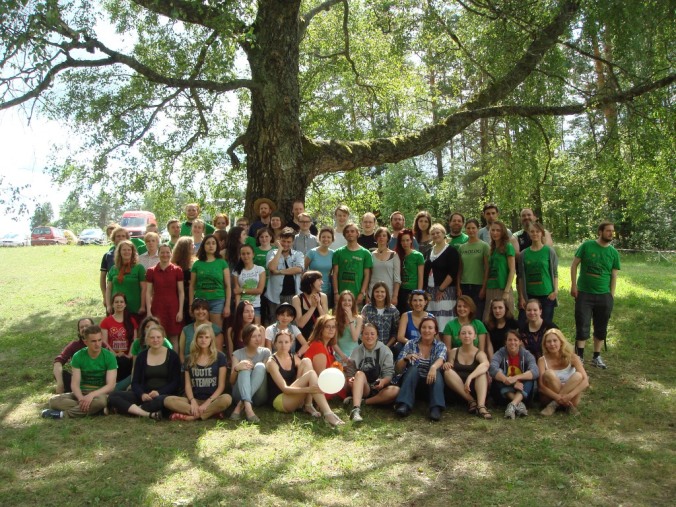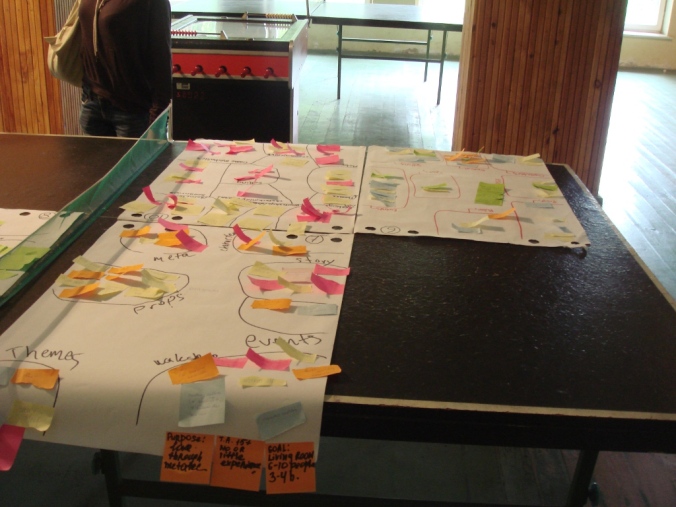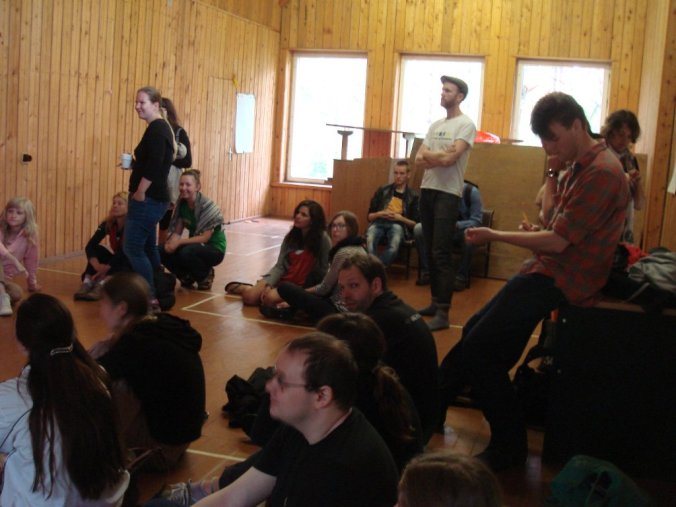Norwegian Fantasiforbundet and belarussian Education Center ”POST” organized the Larp Writer Summer School for the second time in Lithuania, Moletai this summer. Three of the participants came from Finland. Carolina Renman from Turku and Joanna Österman from Helsinki took part in the summer school, and Maija Korhonen from Helsinki attended the Larporatory programme for last summer’s students.

Group picture of the LWS13 attendees
Designing larps for an audience
Before going to the Larp Writer Summer School I had participated in just above 20 larps and organized two small ones. I thougth it wasn’t that much, but I still felt I would understand what the lecturers would be talking about. When I talked to the other participants it became very clear that I was one of the most experienced larpers at the Summer School. It was really difficult to find participants who had attended more than 5 larps before attending the Summer School, except among the participants from the other Nordic countries. Since most participants didn’t have that much experience from larps the lectures were quite basic and sometimes it felt as if the level was too low for me. Despite that I became very consious about all the things you have to consider when writing a larp, more consious than I’ve ever been before. I also learned some important things one should consider when designing a larp, like designing for an audience.
When designing a larp you have to think about whom the larp is for, what kind of players you’re writing the game for. Will the game be for people who like to explore relationships or for people who like to whack the shit out of things during larps? If you make a larp for people who like to explore relationships you have to design the larp so that everybody has intresting relationships and so that there is time to play out the relationships between everything else that is happening. If you make a larp for people who like to kill things you have to have hoards of things the players can kill. Especially if the game is for new players, you have to make certain design choises just to make sure everybody gets what larping is about. Also when you’re writing a larp for “your” group of larpers you have to be consious about what kind of players there are in the group, what they are used to and like to larp and what expectations they have, and that will also influence the design of a larp.
This may seem very obvious, but I recently went to a larp that was for “anybody”, except that the GM:s hadn’t been thinking about what that would mean for the larp and it became very prominent during the larp. One example of that is that in one small group, that had been put together by the GM:s, there were people who like to kill things, people who like relationships and immersionists. During the larp that group dissolved, because they didn’t have a lot that kept them together. So the most important thing I learned during the Summer School is that you should always think about who the larp you create is for and how that affects the larp, both for you as a GM and for the players.
– Carolina Renman, participant in the Larp Writer Summer School 2013.

Design in progress
Working with the mixing desk
I participated in the Larporatory pilot project aimed for last year’s participants. Our goal was to write larps in small groups in just two and a half days. We began by pitching ideas on the internet during the spring, selected a few of them and split in five groups. When we met in Vilnius on the Wednesday evening before the Larporatory, it seemed almost impossible to have the larps ready by Saturday. However, during the Larporatory we had the summerschool experts helping us out – we presented our ideas for them in daily meetings and got some feedback and criticism. In addition all the teams had a coach or two to supervise the process more closely.
We began our game writing with a ”post-it method” for co-creation:
- Start by defining a goal and a purpose for your larp. Goal means here something concrete, e.g. ”This is a larp for a high school class”. Purpose is the desired outcome of the larp, e.g. ”I want to make them pay attention to our different use of personal space.”
- Take 2- 4 minutes to create as many ideas for the larp as possible. Write all the ideas on post-its, and avoid self criticism.
- Share your ideas with the whole team and place the post-its on large poster.
- Take another couple-of-minutes session to come up with some more ideas.
- Share your ideas again.
- Categorize your post-its on the poster by moving them under different titles, e.g. ”characters”, ”story” or ”metatechniques”.
- Go through all the ideas, this time more slowly, and compare them with the goal and the purpose you defined at the beginning. Throw away all the post-its that don’t fit your vision. (Try to make this phace of killing your darlings as fun as possible!)
- Tadaa! You should now have a basic concept for your larp.
The working process was structured with some milestones. By the first evening we were supposed to have our character concepts ready and were supposed to present them to the experts. Our creative process didn’t really follow the set milestones, and it was a bit painful to pitch unfinished ideas. The pitching in the middle of writing was very useful though – we got a lot of valuable input from the experts that compensated for the lack of time.
The teams concisted of larpers from different cultures with different larp traditions. The mixing desk of larp proved to be most usefull, when the team members had different visions of the larp. We found out that we were almost always disputing about some fader or another: Sometimes we had different views about the abstraction level of the larp, sometimes about how close-to-home we wanted our game to be played.
All groups finished their larps in time, and the summer school participants playtested them on Saturday. Unfortunately we didn’t have time to play each other’s games, but from what I heard, all of the games were succesfull. Many of the Larporatory participants were writing a scenario for the first time, so all of a sudden we had a lot of new larp writers. Right now our group is working with the feedback we got from our players to fix the game for this autumn’s Grenselandet festival in Oslo.
I learned in this year’s summer school that my ideal larp writing experience consists of three things: First, I need a group to work with. Even though working in a group means a lot of negotiations and compromises, it also means instant feedback and lots of funny moments toying around with your ideas. Second, It’s good to talk about the larp to more experienced larp designers while still working with the script, and also after the playtesting. More experienced people spot the problems with design more easily, and are also a great source of confidence. Even though you wouldn’t take their advice, you’ve already learned a lot trying to explain your idea to them. Third and final thing: I learned to appreciate the time I usually have between the larp writing meetings. The ability to ponder your choices properly and sleep on your decisions. What a luxury!
-Maija Korhonen, participant of the Pilot Larporatory 2013, who wrote a larp called Toast to the War together with Hilda Levin and Leïla Teteau-Surel.

LWS13 in action
Lifelike larp: importance of emotional safety
“Larp is not inherently dangerous – life is”, was one of the opening notes by Joc Koljonen on the subject of physical and emotional safety in larps. I’m going to focus on the latter, and try to answer the question of why we need debriefs for emotional safety after a larp. The answer, to put it simply, is because of the way our mind works.
In the Finnish larps I’ve been to, there has usually been time for re-constructing the story and evaluating the game. Creating an emotionally safe environment to process the larp has been up to the players themselves.
To understand why debrief is important, we need to look at some factors that makes us human. Joc used the word “hamster” to describe players as primordial beings for the way the sensory system works. Part of the system can’t tell the difference between fiction and the real world. It’s one of the reasons to why we enjoy storytelling; we can relate to the fiction. Since our brains can’t tell the difference between what is “real” and what is “fiction”, emotions shouldn’t be divided into “real” and “fictional”. After all, a player and her character share the same emotions even if the setting is made up. Accepting this hard fact, it’s easier to talk about bleed, which happens when fictional events blend into real life and vice versa.
However much bleed has been experienced in a larp, players tend to get sad. Some want hang onto an utopia, but can’t continue doing so since the time and place of the larp has passed. Players grieve for the loss of a fictional world, because a sense of belonging is important for any human being. Sometimes the sadness comes from how the larp reflects the state of the world.
Part of real life safety comes from being socially accepted. When we create fictional temporary relationships and a new identity, it’s a threat to our own identity. The fictional identity needs confirmation just like the real one. Post-game, players might want to leave behind or embrace a part of their character. Having played eg. a lifesaver for a day, they might want to include that bravery in their real life. This should be encouraged.
Post-game, players should construct the story together and evaluate their experience, but it also takes time and space to process thoughts and emotions that have come up, both in and out of character. The game doesn’t simply end when the larp itself is over: this is normally when processing of the magic circle start. Also this, I think, should be encouraged by the organiser. Larp is social: have players process it accordingly. The outcome of individual experiences is hard to predict, but it’s the organiser’s responsibility to check that there is a general agreement on what can be done for people to have as low a threshold as possible to talk about their experiences to eachother. Everyone needs a bit of confirmation, whether they admit it or not.
– Joanna Österman, LWSS 2013 participant
Paluuviite: Kultainen lohikäärme | Loki